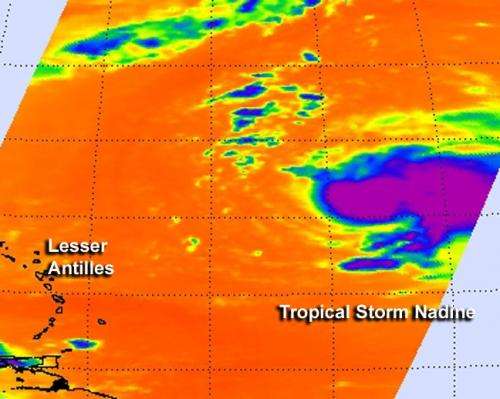NASA's Aqua satellite passed over Tropical Storm Nadine on Sept. 13 at 01:23 a.m. EDT. AIRS infrared data found the strongest thunderstorms (purple) with very cold cloud temperatures being pushed east of the center by wind shear. Credit: Ed Olsen, NASA/JPL
Tropical Storm Nadine is struggling against wind shear and some dry air. Infrared satellite imagery from NASA showed that Nadine's most powerful thunderstorms were being pushed east of the center.
NASA's Aqua satellite passed over Tropical Storm Nadine early on Sept. 13 and saw several factors that indicated the storm was still struggling to achieve hurricane status.
Infrared data from the Atmospheric Infrared Sounder (AIRS) that flies aboard Aqua found the strongest thunderstorms with very cold cloud temperatures (colder than -63F/-52C) were being pushed east of Nadine's center by wind shear.
An animation of satellite observations from Sept. 9-13, 2012, shows large Tropical Storm Leslie north of Bermuda, tiny Hurricane Michael east of Leslie and the development of Tropical Storm Nadine in the central Atlantic. This visualization was created by the NASA GOES Project at NASA Goddard Space Flight Center, Greenbelt, Md., using observations from NOAA's GOES-13 satellite. Credit: NASA/NOAA GOES Project
Although Nadine is expected to reach hurricane status later on Sept.13 or Sept. 14, the storm did not yet develop an eye. The AIRS infrared image also showed that Nadine's cloud pattern was not symmetric, and a tropical cyclone needs symmetry to intensify. If the moderate southwesterly wind shear relaxes, Nadine will have a better chance of intensifying. Satellite data also suggests that intrusion of mid-level dry air, which is also sapping Nadine's strength.
At 11 a.m. EDT on Sept. 13, Tropical Storm Nadine's maximum sustained winds were just under hurricane strength, near 70 mph (110 kmh). The National Hurricane Center noted that Nadine could become a hurricane later on Sept. 13 (today). The center of Tropical Storm Nadine was located near latitude 22.6 north and longitude 52.2 west, about 770 miles (1,235 km) east-northeast of the Northern Leeward Islands. Nadine is moving toward the northwest near 16 mph (26 kmh) and the National Hurricane Center expects Nadine to turn to the north-northwest and later to the north.
Provided by NASA's Goddard Space Flight Center
























